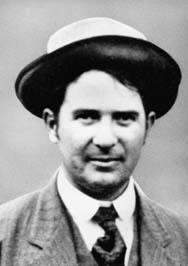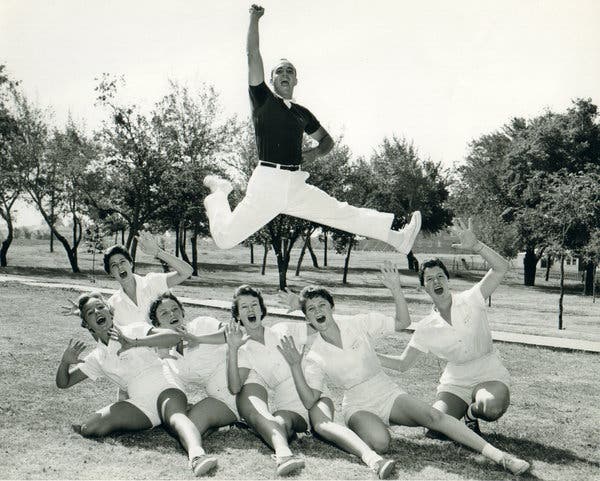History of Cheerleading
For as long as civilization has formed groups, the idea of yelling encouragement has been around. Think about the crowds cheering for (or against) the gladiators at the coliseum in Rome. But what we think of today as “cheerleading” has only been in place for just over a hundred years. Even with that short history, cheerleading is still growing and developing new disciplines that are exciting to watch, coach, and participate in!
Crowd Cheers
The first known organized cheers and change that began what we know as cheerleading took place at Ivy League college sporting events in the 1860’s. The first known “cheer” in the US was shouted from the crowd at Princeton University in 1884:
Ray, Ray, Ray!
Tiger, Tiger, Tiger!
Sis, Sis, Sis!
Boom, Boom, Boom
Aaaaah! Princeton, Princeton, Princeton!
It was when an 1882 Princeton University graduate, Thomas Peebles, took this idea to the University of Minnesota that cheerleading as we know it was about to start.
The First Cheerleader
 Up until November 2, 1898 the cheers and chants broke out from the crowd itself spontaneously. Very likely, they weren’t always done in unison, and may have even had competing groups trying to start their own chants.
Up until November 2, 1898 the cheers and chants broke out from the crowd itself spontaneously. Very likely, they weren’t always done in unison, and may have even had competing groups trying to start their own chants.
It was that day that a University of Minnesota student, Johnny Campbell, got up from the seats and took the field in order to lead the student body in a chant:
Rah, Rah, Rah!
Ski-u-mah!
Hoo-Rah! Hoo-Rah!
Varsity! Varsity! Varsity,
Minn-e-So-Tah!
He jumped over the fence, and cheerleading as we know it was born. The “birthday of cheerleading” is celebrated annually on November 2nd.
Cheerleading Grows
Other students soon joined Johnny on the field, and as opposing fans saw the effectiveness of having a group fire up the crowd, “Yell Leaders” started sprouting up all across college campuses. As it grew, cheerleaders started adding many of the elements we know today, such as megaphones to be louder, arm motions for crowds to keep time, signs, poms, and even basic jumps, tumbling, and stunts (more commonly called “lifts” back in the day!)
Britannica gives the following early history of cheerleading as a sport in the U.S.:
“Although cheerleading is today predominantly associated with femininity, the original cheerleaders were men. Cheerleading was connected to the emergence of gridiron football at Ivy League colleges and universities in the United States in the mid-1800s, and the growth and formalization of cheerleading paralleled that of football. Over the latter half of the 19th century, as attendance at college games grew, large stadiums were constructed, and spectators were distanced from the playing field. Cheerleaders — or “yell leaders,” as they were then called — led cheers from the sidelines both to encourage the spectators and to serve as a form of crowd control. By the 1920s cheerleading had become a formal extracurricular activity for boys in high schools, colleges, and communities across the country, related to but distinct from other spirit programs such as marching bands, drum corps, and drill teams. As ambassadors for their schools and communities, cheerleaders were associated with such character-building traits as discipline, cooperation, leadership, and sportsmanship.”
Cheerleading Becomes Female
While women were permitted to be on cheerleading teams, yell leaders were predominantly male up until World War II. With “the men going off to war”, women filled the role on the sidelines. Once the war was over, cheerleading remained overwhelmingly a female activity. Today, females account for approximately 85% of participants.
Camps and Competitions
 In 1949, Lawrence “Herkie” Herkimer was asked to administer a cheerleading educational clinic at the Texas Teacher’s College (now Sam Houston State University). The clinic drew 52 cheerleaders, which prompted a second clinic which had 350 cheerleaders in attendance. Herkie created the first cheerleading training organization, the National Cheerleaders Association, and began teaching basic partner stunts, jumps, and crowd-leading techniques to cheerleaders across the country. Soon, other similar organizations sprang up regionally and nationally to conduct training camps.
In 1949, Lawrence “Herkie” Herkimer was asked to administer a cheerleading educational clinic at the Texas Teacher’s College (now Sam Houston State University). The clinic drew 52 cheerleaders, which prompted a second clinic which had 350 cheerleaders in attendance. Herkie created the first cheerleading training organization, the National Cheerleaders Association, and began teaching basic partner stunts, jumps, and crowd-leading techniques to cheerleaders across the country. Soon, other similar organizations sprang up regionally and nationally to conduct training camps.
Athleticism
As the popularity of cheerleading grew, jumps, tumbling, stunts, and pyramids began evolving into ever-increasing feats of athletic ability.
The early 1970’s saw the passage of Title IX, which prohibited federally-funded educational institutions from discriminating against students based on sex. High schools and colleges began adding female sports to their athletic departments. What this meant for cheerleading was that cheerleaders who participated in other athletics became stronger and more agile. They brought this athleticism from their other sports back to cheerleading.
In the late 70’s and early 80’s, the first televised cheerleading competitions gave cheerleaders across the country visions of what skills the best cheerleaders were able to perform. Now, instead of regional pockets of talent, cheerleading tumbling, jumps, and pyramid skills began to take off all across the U.S.
Expanding Beyond The Sidelines
Along with the increased athleticism and popularity of competition came a demand for more opportunities for cheer. While more and more would be cheerleaders were trying out for the team, school programs were limited to the set number of athletes they allowed. In the late 1980’s, the first cheer programs outside of the school setting were formed and called “All Star”. While some all star programs were initially developed to assist in making the school cheer program, all star quickly developed into its own discipline that attracted athletes who wanted to focus on the competitive side of cheer without cheering on a crowd in support of another team.
All Star cheer competitions were initially part of the existing school competitions, but as their popularity grew, the US All Star Federation (USASF) was created to provide training, rules, and competition guidelines. All Star cheer has over 150,000 participants.
Safety and Education
As the popularity, and particularly the athleticism of cheerleading grew, there came with it increased safety concerns. While educational training organizations existed, there was no one set of specific set of rules that limited the skills being performed. As teams watched and tried to mimic the skills they saw on televised games or televised cheerleading competitions, the athleticism was outpacing the ability to safely coach those skills.
In the early 1980’s, UCA published a set of safety guidelines for cheerleaders. The National Federation of High Schools (NFHS) published their first Spirit Rules Book shortly thereafter. In 1987, the American Association of Cheerleading Coaches and Advisors (AACCA) was formed to develop, promote, and educate coaches in the areas of safety rules and risk minimization. Dr. Gerald S. George was selected to be the senior editor of the first AACCA Cheerleading Safety Manual, published in 1990, and to develop a training course for coaches. This manual and course become the standard of care for cheerleading safety.
To address All Star cheer programs, the USASF was formed in 2003. The USASF developed training programs and rules for the various levels of All Star.
In 2007, USA Cheer was formed with one of its missions being the promotion of safety and safety education for cheer in the United States. USA Cheer and AACCA work together to increase awareness of cheerleading safety and education.
Serious injuries declined as safety education and awareness grew, in large part due to requirements put in place by state associations and college associations. Today, cheerleading is consistently in the lower quarter of injury rates in high school sports.
In 2018, USA Cheer brought the AACCA under its governance and continues safety education through the rules process, the USA Cheer Safety & Risk Management manual and course, and additional safety training.
Cheerleading Goes International
As television broadcasts like the cheerleading championships seen on ESPN reached across the globe, interest in cheerleading grew abroad. It expanded so quickly that in 2004, the International Cheer Union (ICU) was formed to provide a global governing body for cheer. Governing body status was granted in 2013 as the ICU was welcomed by the SportAccord General Assembly.
USA Cheer was formed in 2007 to be the governing body representing the USA in the ICU. Its three-fold mission is to promote safety and safety education for cheer in the United States; help grow and develop interest and participation in cheer throughout the United States; and represent the United States of America in international cheer competitions. Formal recognition as the governing body for the USA was granted by the ICU in 2009.
In 2021, the ICU was granted full recognition status by the International Olympic Committee.
Development of STUNT
In 2011 a new discipline of cheer called STUNT was developed to provide additional opportunities to participate in cheer. While cheerleading is clearly athletic, the Office of Civil Rights has repeatedly determined that it does not fit the criteria to qualify for Title IX requirements at the high school and college level. This is in large part due to the dual role cheerleaders play.
STUNT created a new competitive-focused format that removed the support role from traditional cheerleading and kept the athletic components. Instead of dozens or more teams coming together to show their two and a half minute routines filled with team-choreographed skills and cheers, a STUNT game would consist of only two teams competing in a head-to-head, four quarter format similar to other sports games. With this format, STUNT can be implemented to fit Title IX requirements while providing and exciting athletic opportunity to more women.
STUNT is one of the fastest growing female sports in the world, growing quickly to become a collegiate varsity and club sport at over 50 institutions, and is being played in 16 states as a sanctioned sport or club. STUNT has been granted emerging sport status by the NCAA.
Present Day
Currently, cheerleading is one of the most popular activities across the US and around the globe – with over 3 million cheerleaders in the US participating in youth rec, all star, school cheer, and STUNT, and hundreds of thousands worldwide. With the recent recognition by the IOC and USOPC, there’s no signs of slowing down the growth and interest for cheer!

